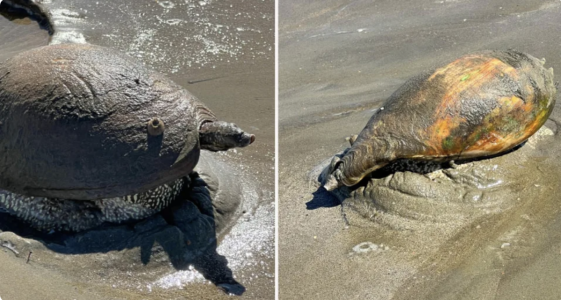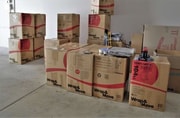Woman shares ‘very large’ discovery at the beach: ‘So interesting to watch’
By
Seia Ibanez
- Replies 2
When Amanda Mee set out for a leisurely stroll with her partner on Pallarenda Dog Beach in Townsville, Queensland, she expected a typical day by the sea with her furry friend.
What she didn't anticipate was stumbling upon a marine marvel that would leave her in awe.
The discovery? A 'very large' and rare live sea snail, nestled within its shell on the sandy shores.
Amanda was left in awe when she stumbled upon what she initially thought was a large, abandoned shell.
The discovery was as unexpected as it was fascinating. Amanda and her partner were intrigued by the shell's size and decided to investigate further.
'We originally thought it was a large shell, so my partner decided he would try and pick it up, and it moved,' Amanda shared.
‘So he dug the sand out from around it and [a snail] emerged from its shell.’
The couple's curiosity led them to gently unearth the creature, revealing a live snail emerging from its shell, a sight Amanda described as 'so interesting to watch’.
Sea snails, often sought after for their beautiful shells, are not commonly found alive on the beach, making Amanda's find particularly special.
The snail in question was identified as a Bailer or Baler shell, a northern species more typically found along the Western Australia coast and across the Northern Territory coast to Queensland.
This marine mollusc, part of the gastropod family Volutidae, can weigh around a kilo and is known for its impressive size, with some reaching up to about 45 centimetres.
The northern baler’s natural habitat is the seafloor in sandy areas where they can bury themselves for camouflage and protection.
Amanda and her partner witnessed this behaviour firsthand as the snail began 'burying itself in the sand' after their encounter.
While the couple was cautious, not knowing if the snail was poisonous, they took the opportunity to capture photos and observe the creature as it returned to its sandy refuge.
‘We had to be careful. Once we uncovered it, we took some photos and watched it dig itself back into the sand,’ she said.
Amanda's post about the ‘amazing find’ drew attention and admiration from others, with many expressing that they had only ever found empty shells, never one with its original inhabitant still inside.
The baler shell's unique appearance, including what Amanda described as 'a strange horn-looking head’, sparked a mix of reactions, from awe to humour.
‘That's one ugly-looking sea monster slug, whatever it is,’ one person joked.
‘It’s a Baler shell. I have quite a few,’ another said.
Baler shells come in many varieties, some are even considered a delicacy.
The False Bailer Shell, commonly found off the southeast coast of Australia, is known for its distinctive orange foot and is highly prized in culinary circles.
However, less common species, such as the black-footed variety and melon shells, are also part of Australia's diverse marine life.
Despite the temptation to collect such intriguing specimens, authorities urge beachgoers to admire these creatures from a distance.
Western Australia's Department of Biodiversity, Conservation and Attractions advises against touching or moving live baler shells.
‘If you see a live baler shell, please marvel at their beautiful shells and colouring, but leave them where you find them for others to enjoy,’ it said.
‘You may not collect shells, even those that are dead, from below the high water mark of most marine parks in WA, as they often provide homes for other marine animals.’
Speaking of amazing finds, other beachgoers shared their discoveries as well.
In a previous story, a man found a mysterious metal ball at a Queensland beach, which he claimed to be not from this world.
What mysterious object could this be? Read more about it here to find out.

Have you ever encountered a rare or unexpected find while enjoying Australia's beautiful coastlines? We'd love to hear about your experiences and any photos you might have of these unique moments. Share your stories in the comments below!
What she didn't anticipate was stumbling upon a marine marvel that would leave her in awe.
The discovery? A 'very large' and rare live sea snail, nestled within its shell on the sandy shores.
Amanda was left in awe when she stumbled upon what she initially thought was a large, abandoned shell.
The discovery was as unexpected as it was fascinating. Amanda and her partner were intrigued by the shell's size and decided to investigate further.
'We originally thought it was a large shell, so my partner decided he would try and pick it up, and it moved,' Amanda shared.
‘So he dug the sand out from around it and [a snail] emerged from its shell.’
The couple's curiosity led them to gently unearth the creature, revealing a live snail emerging from its shell, a sight Amanda described as 'so interesting to watch’.
Sea snails, often sought after for their beautiful shells, are not commonly found alive on the beach, making Amanda's find particularly special.
The snail in question was identified as a Bailer or Baler shell, a northern species more typically found along the Western Australia coast and across the Northern Territory coast to Queensland.
This marine mollusc, part of the gastropod family Volutidae, can weigh around a kilo and is known for its impressive size, with some reaching up to about 45 centimetres.
The northern baler’s natural habitat is the seafloor in sandy areas where they can bury themselves for camouflage and protection.
Amanda and her partner witnessed this behaviour firsthand as the snail began 'burying itself in the sand' after their encounter.
While the couple was cautious, not knowing if the snail was poisonous, they took the opportunity to capture photos and observe the creature as it returned to its sandy refuge.
‘We had to be careful. Once we uncovered it, we took some photos and watched it dig itself back into the sand,’ she said.
Amanda's post about the ‘amazing find’ drew attention and admiration from others, with many expressing that they had only ever found empty shells, never one with its original inhabitant still inside.
The baler shell's unique appearance, including what Amanda described as 'a strange horn-looking head’, sparked a mix of reactions, from awe to humour.
‘That's one ugly-looking sea monster slug, whatever it is,’ one person joked.
‘It’s a Baler shell. I have quite a few,’ another said.
Baler shells come in many varieties, some are even considered a delicacy.
The False Bailer Shell, commonly found off the southeast coast of Australia, is known for its distinctive orange foot and is highly prized in culinary circles.
However, less common species, such as the black-footed variety and melon shells, are also part of Australia's diverse marine life.
Despite the temptation to collect such intriguing specimens, authorities urge beachgoers to admire these creatures from a distance.
Western Australia's Department of Biodiversity, Conservation and Attractions advises against touching or moving live baler shells.
‘If you see a live baler shell, please marvel at their beautiful shells and colouring, but leave them where you find them for others to enjoy,’ it said.
‘You may not collect shells, even those that are dead, from below the high water mark of most marine parks in WA, as they often provide homes for other marine animals.’
Speaking of amazing finds, other beachgoers shared their discoveries as well.
In a previous story, a man found a mysterious metal ball at a Queensland beach, which he claimed to be not from this world.
What mysterious object could this be? Read more about it here to find out.
Key Takeaways
- A Queensland woman came across a very large, live baler shell snail while visiting Pallarenda Dog Beach in Townsville.
- The sea snail was initially mistaken for a large empty shell until it exhibited movement and was later identified as a northern species of baler shell.
- While many who responded to her post were amazed by the find, it was noted that live baler shells should not be disturbed, and empty shells should not be taken from below the high-water mark in marine parks.
- Some sea snails can be cooked and eaten, the false baler shell being one example, but also emphasised the importance of not handling them due to potential risks like toxicity or the regulations protecting marine life.








